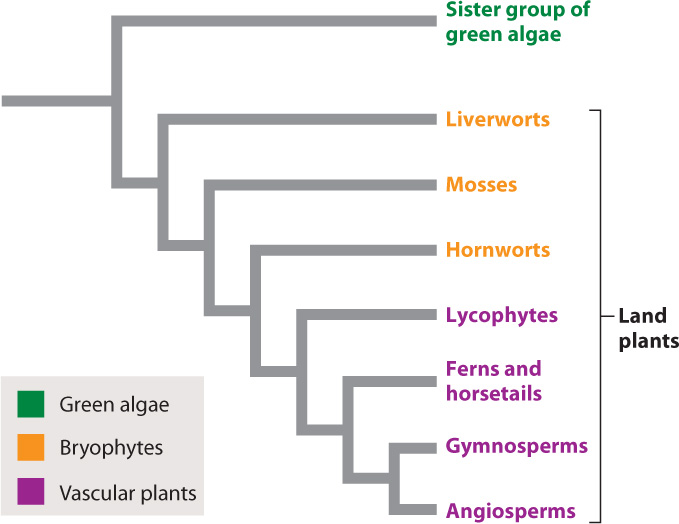29.1 PLANT STRUCTURE AND FUNCTION: AN EVOLUTIONARY PERSPECTIVE
Phylogeny provides a road map of land plant evolution. We will reserve detailed discussion of plant diversity until we have discussed how plants function, and we begin now with a quick sketch of evolutionary relationships among land plants. Fig. 29.1 shows that land plants form a monophyletic group descended from green algae. The land surface, in turn, is covered by two groups of plants: the bryophytes (which include the mosses, along with the less-familiar liverworts and hornworts) and the vascular plants. For many years, botanists treated both bryophytes and vascular plants as monophyletic, but phylogenetic analysis based on molecular sequences makes it clear that bryophytes are a paraphyletic grouping, including some of but not all the descendants of a common ancestor. Note in Fig. 29.1 that the descendants of the last common ancestor of bryophytes also include vascular plants.

Vascular plants make up more than 95% of all land plant species found today, and they similarly dominate the photosynthetic output of terrestrial environments. The phylogenetic tree shows that vascular plants form a monophyletic group, with four main subgroups, three of which are probably familiar to you. Ferns and horsetails form a monophyletic group, as do plants that reproduce by seeds. Molecular sequence comparisons suggest that living seed plants can be subdivided into two monophyletic groups, gymnosperms and angiosperms. The gymnosperms include pine trees and other conifers. The angiosperms, or flowering plants, include oak trees, grasses, and sunflowers.
29-2
The fourth major vascular plant group, the lycophytes, may be less familiar. This group is particularly interesting to scientists because it forms the sister group to all other vascular plants. Keep Fig. 29.1 in mind as you read the next several chapters because, while the major groups of vascular plants share many features, they have each evolved distinctive variations in growth, anatomy, and reproduction that help to explain their present-day diversity and distribution.
The evolution of vascular plants was a game-changing event in the history of life. To appreciate why this is so, we have to understand the “game” played by the lineages that preceded the vascular plants. In particular, how are the bryophytes (the three groups of nonvascular land plants) able to survive on land? Bryophytes do not produce roots and so are totally dependent upon surface water to keep their photosynthetic cells hydrated. As the environment dries, so do they.

All cells require a high degree of hydration to function. As bryophytes dry out, they lose the ability to carry out photosynthesis. However, many bryophytes exhibit desiccation tolerance, a suite of biochemical traits that allows their cells to survive extreme dehydration without damage to membranes or macromolecules (Fig. 29.2). Bryophytes can then resume photosynthesis when surface water is once again available. In contrast to bryophytes, vascular plants maintain the hydration of their photosynthetic cells by drawing upon water in the soil. As a result, vascular plants can photosynthesize across a wider range of environments and conditions than can bryophytes.
Bryophytes provide insights into how the first plants may have dealt with the challenge of carrying out photosynthesis on land. The ability to survive desiccation is likely to have been critical. But we must avoid the temptation to think of living bryophytes as representative of the ancestral state. Bryophyte diversity has been shaped by their long coexistence with vascular plants. Indeed, bryophytes thrive today only in places where roots would not provide a significant advantage—on rocks and the trunks of trees, for example, and in regions too dry or too cold for roots to penetrate the soil.
We will return to bryophytes when we examine plant reproduction (Chapter 30) and diversity (Chapter 33). For now, however, let’s focus on the vascular plants.